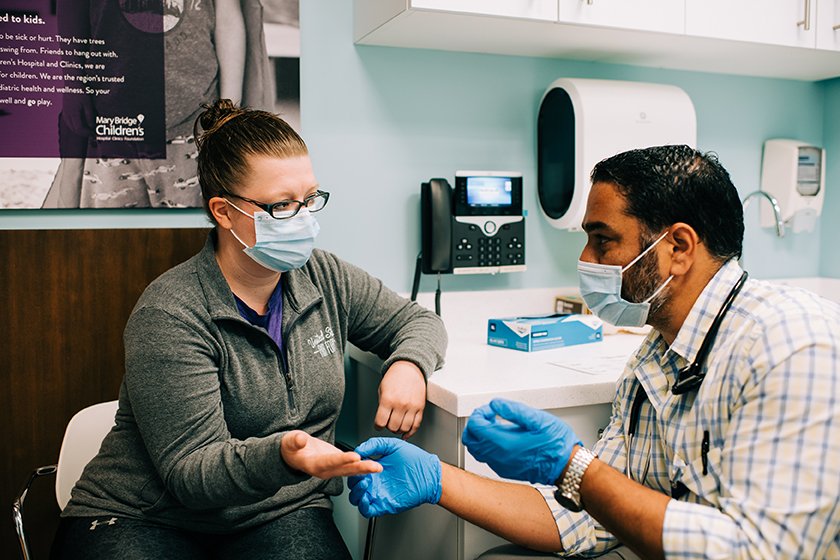From kitchen mishaps to tumbles in the gravel, cuts and scrapes happen. And while most can be treated at home, deeper lacerations may require stitches to ensure they heal properly.
In many cases, stitches will help ensure proper healing and reduce the chance of developing scar tissue. Deep cuts are also prone to infection and other complications. The longer a wound is open and exposed, the greater the risks. Depending on your injury, you may also need a tetanus shot or antibiotics.
Here are some common questions and answers that will help you determine when your cut needs more than just a bandage.
How do I know I need stitches?
While a medical professional can best evaluate your injury and determine a treatment plan, there are some indicators you may need stitches or other medical attention:
- The cut is deeper or longer than half an inch, deep enough to expose muscle, bone or fatty tissue, or wide or gaping.
- The wound is located across a joint, on the face, on or near your eye, or on or near the genitalia.
- You have a deep wound caused by an animal bite or scratch or a rusty or contaminated object.
- The wound contains debris, such as gravel or broken glass.
- There is profuse bleeding from the injured area.
If it looks like you or your little one may need stitches, here are a few tips on what to do before you head out for medical care:
- Apply pressure. Use a clean cloth or bandage to apply continuous, direct pressure to the wound for 5 to 10 minutes, and try to elevate the injured area. If blood soaks through, put another one bandage or cloth on top of it.
- Leave foreign objects alone. If something is stuck in the wound, leave it there. Don’t attempt to touch or remove anything on your own.
What types of cuts and wounds can be treated at urgent care?
MultiCare Indigo Urgent Care can clean and treat your minor cuts and scrapes, including lacerations that require stitches.
Here are instances when you should visit a nearby Indigo location:
- Straight cuts that have edges that you can easily push together
- Shallow facial cuts
- Cuts and abrasions that have embedded dirt
- Animal or human bites that are not very deep
- Cuts that are not serious but were caused by rusty and dirty objects
Your cut or wound may be more serious. Go to an emergency department if:
- The cut is long, deep or gaping.
- The bleeding is heavy or will not stop after applying direct pressure for 10 minutes.
- The cut or abrasion is on your genitalia, or on or near your eye.
- You have numbness or tingling around the area of the wound.
- A foreign object is stuck in the wound.
Does it hurt to get stitches?
It’s natural to be anxious about getting stitches, and your care team will do everything possible to help put you at ease. During your visit, your medical provider will gently clean the injured area with water, saline and soap. A local anesthetic will be given to numb the area. While it may sting for a moment, you won’t feel any pain or discomfort once the area is numb.
Using a curved needle, your provider will close the wound with stitches. You may feel a tugging sensation as the stitches are pulled together.
How do I take care of my stitches at home?
Your medical provider will give you specific instructions on how to care for your stitches as the cut or wound heals. In general, you should:
- Keep the area free from moisture and water.
- Change bandages on a regular basis.
- Use antibiotic ointments to help healing.
- Take acetaminophen or ibuprofen for pain, if needed.
Contact your medical provider if you have any concerns, or if there are signs of infection (a fever higher than 100 degrees, increased redness, warmth or swelling, or red streaks on the skin near the wound), or your stitches pop or break.
How long do stitches last?
Stitches typically need to remain in place for several days to a couple of weeks, depending on the severity of the cut and location. Your provider will tell you when to come back to have the stitches removed.
Will stitches come out on their own or do they need to be removed?
While removing stitches is not a difficult process, don’t try to remove them on your own. When your medical provider removes your stitches, they will look for signs of infection and make sure the wound is healing properly. They may also have instructions for you after the stitches are removed, which may help minimize scarring.
Safe care, when you need it
If you think you or a loved one might need stitches, don’t delay medical treatment. Indigo Urgent Care locations are open from 8 am to 8 pm every day, even weekends and holidays. Schedule an appointment online to save your spot, and rest assured we have strict guidelines in place to keep you safe when you visit.
Find an Indigo Urgent Care location near you.


